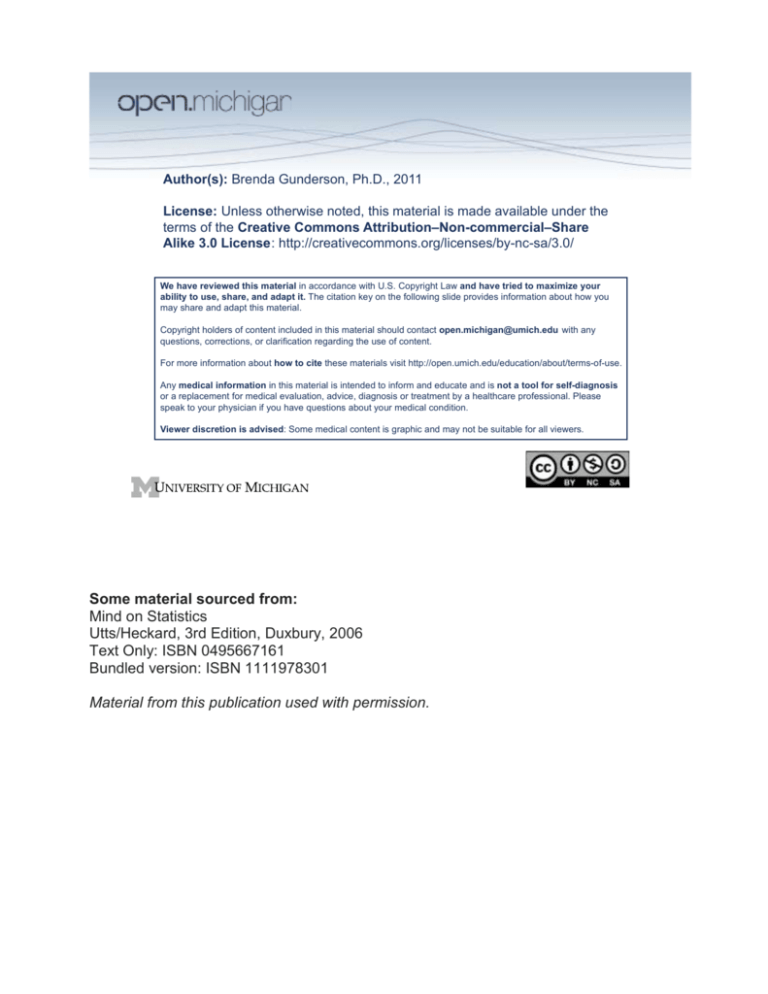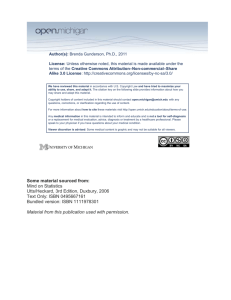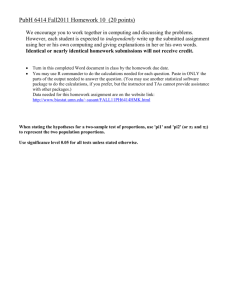14-f11-bgunderson-iln-differenceinproportionspart3
advertisement

Author(s): Brenda Gunderson, Ph.D., 2011
License: Unless otherwise noted, this material is made available under the
terms of the Creative Commons Attribution–Non-commercial–Share
Alike 3.0 License: http://creativecommons.org/licenses/by-nc-sa/3.0/
We have reviewed this material in accordance with U.S. Copyright Law and have tried to maximize your
ability to use, share, and adapt it. The citation key on the following slide provides information about how you
may share and adapt this material.
Copyright holders of content included in this material should contact open.michigan@umich.edu with any
questions, corrections, or clarification regarding the use of content.
For more information about how to cite these materials visit http://open.umich.edu/education/about/terms-of-use.
Any medical information in this material is intended to inform and educate and is not a tool for self-diagnosis
or a replacement for medical evaluation, advice, diagnosis or treatment by a healthcare professional. Please
speak to your physician if you have questions about your medical condition.
Viewer discretion is advised: Some medical content is graphic and may not be suitable for all viewers.
Some material sourced from:
Mind on Statistics
Utts/Heckard, 3rd Edition, Duxbury, 2006
Text Only: ISBN 0495667161
Bundled version: ISBN 1111978301
Material from this publication used with permission.
Attribution Key
for more information see: http://open.umich.edu/wiki/AttributionPolicy
Use + Share + Adapt
{ Content the copyright holder, author, or law permits you to use, share and adapt. }
Public Domain – Government: Works that are produced by the U.S. Government. (17 USC §
105)
Public Domain – Expired: Works that are no longer protected due to an expired copyright term.
Public Domain – Self Dedicated: Works that a copyright holder has dedicated to the public domain.
Creative Commons – Zero Waiver
Creative Commons – Attribution License
Creative Commons – Attribution Share Alike License
Creative Commons – Attribution Noncommercial License
Creative Commons – Attribution Noncommercial Share Alike License
GNU – Free Documentation License
Make Your Own Assessment
{ Content Open.Michigan believes can be used, shared, and adapted because it is ineligible for copyright. }
Public Domain – Ineligible: Works that are ineligible for copyright protection in the U.S. (17 USC § 102(b)) *laws in
your jurisdiction may differ
{ Content Open.Michigan has used under a Fair Use determination. }
Fair Use: Use of works that is determined to be Fair consistent with the U.S. Copyright Act. (17 USC § 107) *laws in your
jurisdiction may differ
Our determination DOES NOT mean that all uses of this 3rd-party content are Fair Uses and we DO NOT guarantee that
your use of the content is Fair.
To use this content you should do your own independent analysis to determine whether or not your use will be Fair.
Stat 250 Gunderson Lecture Notes
Learning about the Difference in Population Proportions
Part 3: Testing about a Difference in Population Proportions
Chapter 12: Section 3 HT Module 2
12.3 HT Module 2: Testing Hypotheses about the
Difference in Two Population Proportions
We have two populations or groups from which independent samples are available,
(or one population for which two groups can be formed using a categorical variable).
The response variable is also categorical and we are interested in comparing the
proportions for the two populations.
Let p1 be the population proportion for the first population.
Let p2 be the population proportion for the second population.
Parameter: the difference in the population proportions p1 – p2.
Sample estimate: the difference in the sample proportions pˆ 1 pˆ 2 .
p1 (1 p1 ) p 2 (1 p 2 )
n1
n2
Standard deviation of pˆ 1 pˆ 2 : s.d.( pˆ 1 pˆ 2 )
Recall from Chapter 11 that the multiplier in the confidence interval was a z* value. So we will
be computing a Z test statistic for performing a significance test.
The standard error used in constructing the confidence interval for the difference between two
population proportions is not the same as that used for the standardized z test statistic.
We will need to construct the null standard error, the standard error for the statistic when the
null hypothesis is true. Let’s start with what the hypotheses will look like.
Possible null and alternative hypotheses.
1. H0:
versus Ha:
2. H0:
versus Ha:
3. H0:
versus Ha:
103
Next we need to determine the test statistic and understand the conditions required for the
test to be valid. The general form of the test statistic is:
Test statistic = Sample statistic – Null value
Standard error
In the case of two population proportions, if the null hypothesis is true, we have p1 - p2 = 0 or
that the two population proportions are the same, p1 = p2 = p. What is a reasonable way to
estimate the common population proportion p?
The general standard error for pˆ 1 pˆ 2 is given by: s.e.( pˆ1 pˆ 2 )
pˆ1 (1 pˆ1 ) pˆ 2 (1 pˆ 2 )
n1
n2
but if the null hypothesis is true, then p̂ is the best estimate for each population proportion
and should be used in the standard error.
So, the null standard error for pˆ 1 pˆ 2 is given by:
And the corresponding test statistic is:
If the null hypothesis is true, this z-statistic will have a _____________ distribution.
This distribution is used to find the p-value for the test.
Conditions: This test requires that the sample proportions are based on independent random
samples from the two populations. Also, all of the quantities n1 pˆ , n1(1 pˆ ) , n2 pˆ , and n2 (1 pˆ )
be preferably at least 10. Note these are checked with the estimate of the common population
proportion p̂ .
From the Stat 250 Formula Card we have the following summary:
Two Population Proportions
Parameter
p1 p 2
Statistic
Large-Sample z-Test
pˆ 1 pˆ 2
104
z
pˆ1 pˆ 2
1 1
pˆ (1 pˆ )
n1 n2
where pˆ
n1 pˆ1 n2 pˆ 2
n1 n2
Try It! Returning Lost Money $$
A random sample of college students was asked if they would return the money if they found a
wallet on the street. They were also asked to report their gender so a comparison could be
made between the two populations of male versus female college students.
Of the 93 women, 83 said they would, and of the 75 men, 53 said they would. Assume these
students represent all college students.
Test the hypothesis that equal proportions of college men and women would say they would
return the money versus the alternative hypothesis that a higher proportion of women would
do so. Use a 5% significance level and show all steps.
105
Additional Notes
A place to … jot down questions you may have and ask during office hours, take a few extra notes, write
out an extra practice problem or summary completed in lecture, create your own short summary about
this chapter.
106











